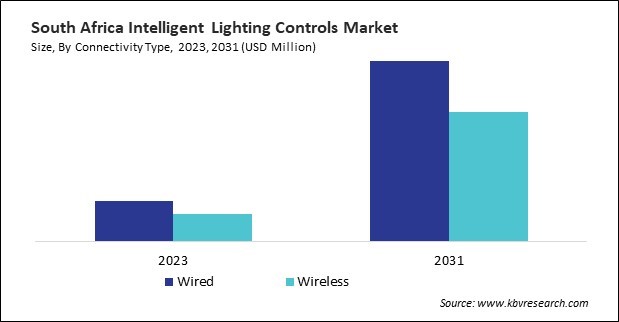The Latin America, Middle East and Africa Intelligent Lighting Controls Market would witness market growth of 20.3% CAGR during the forecast period (2024-2031).
The Brazil market dominated the LAMEA Intelligent Lighting Controls Market by Country in 2023, and would continue to be a dominant market till 2031; thereby, achieving a market value of $973.7 million by 2031. The Argentina market is showcasing a CAGR of 21.2% during (2024 - 2031). Additionally, The UAE market would register a CAGR of 19.9% during (2024 - 2031).

The adoption of these lighting controls has been experiencing significant growth, driven by several key factors highlighting their importance in modernizing lighting systems across various sectors. This section explores the adoption rates, market growth trends, and factors contributing to the expansion of the market. Stringent energy efficiency regulations and sustainability initiatives imposed by governments incentivize the adoption of intelligent lighting controls.
The broader trend towards smart buildings and IoT-enabled infrastructure fuels demand for integrated lighting systems that enhance overall building performance and occupant comfort. Building managers prioritize solutions that offer interoperability with other smart technologies for comprehensive building management. Growing awareness of the impact of lighting on health and well-being drives demand for human-centric lighting solutions. These systems adjust lighting, color, temperature, and intensity throughout the day to align with natural circadian rhythms, supporting better sleep patterns and enhancing productivity.
Increased IoT adoption facilitates the integration of intelligent lighting systems with other smart devices and building management systems in Saudi Arabia. This interoperability enhances efficiency and control over lighting operations. As per the International Trade Administration (ITA), Saudi Arabia’s IoT industry is estimated to reach $2.9 billion by 2025, with a growth rate of 12.8 percent. IoT-enabled lighting controls in Saudi Arabia allow for real-time monitoring and adjustment of lighting based on occupancy, daylight availability, and energy demand. This capability helps in reducing energy consumption and operational costs. IoT technologies provide valuable data analytics regarding lighting usage patterns and energy consumption trends in Saudi Arabia. These insights enable better decision-making for optimizing lighting strategies and improving overall efficiency. Therefore, rising smart city initiatives and expansion of the region's IoT industry are driving the market's growth.
Free Valuable Insights: The Worldwide Intelligent Lighting Controls Market is Projected to reach USD 45.7 Billion by 2031, at a CAGR of 17.6%
Based on Connectivity Type, the market is segmented into Wired and Wireless. Based on Type, the market is segmented into Sensors, Ballast & LED Drivers, Microcontrollers, Dimmers & Switch Actuators, Transmitters & Receivers, and Others. Based on Application, the market is segmented into Smart Cities, Manufacturing, Automotive, Media & Entertainment, and Others.Based on countries, the market is segmented into Brazil, Argentina, UAE, Saudi Arabia, South Africa, Nigeria, and Rest of LAMEA.
By Connectivity Type
By Type
By Application
By Country
Our team of dedicated experts can provide you with attractive expansion opportunities for your business.

